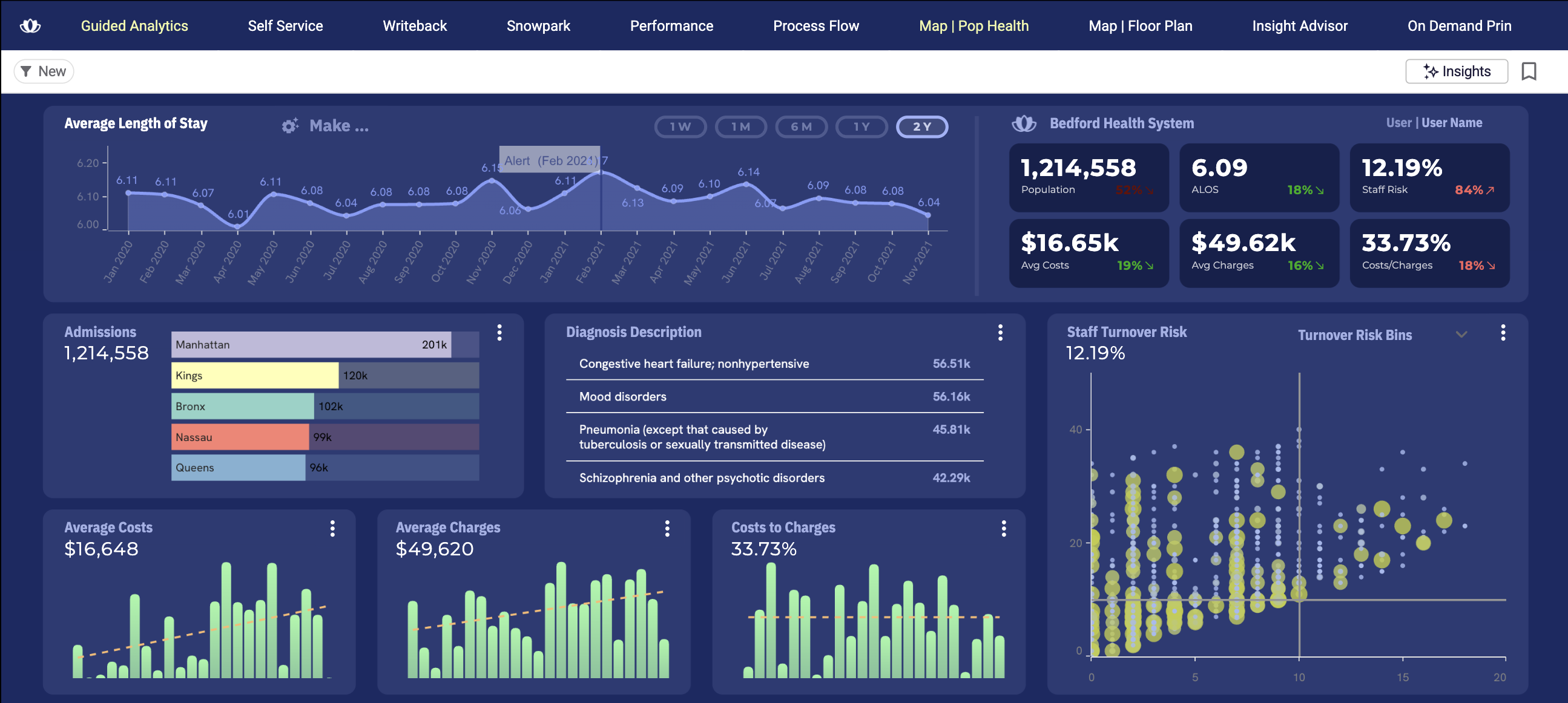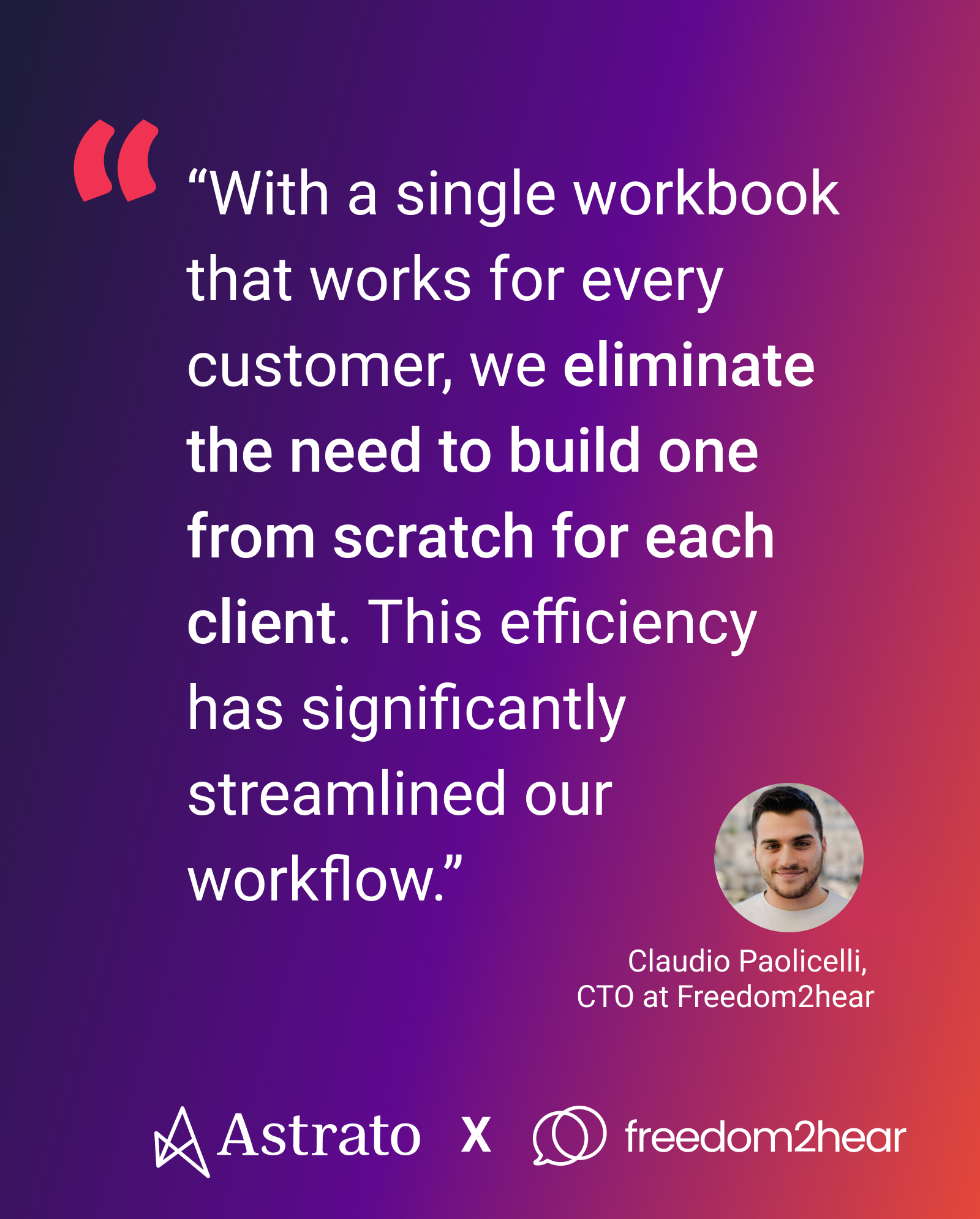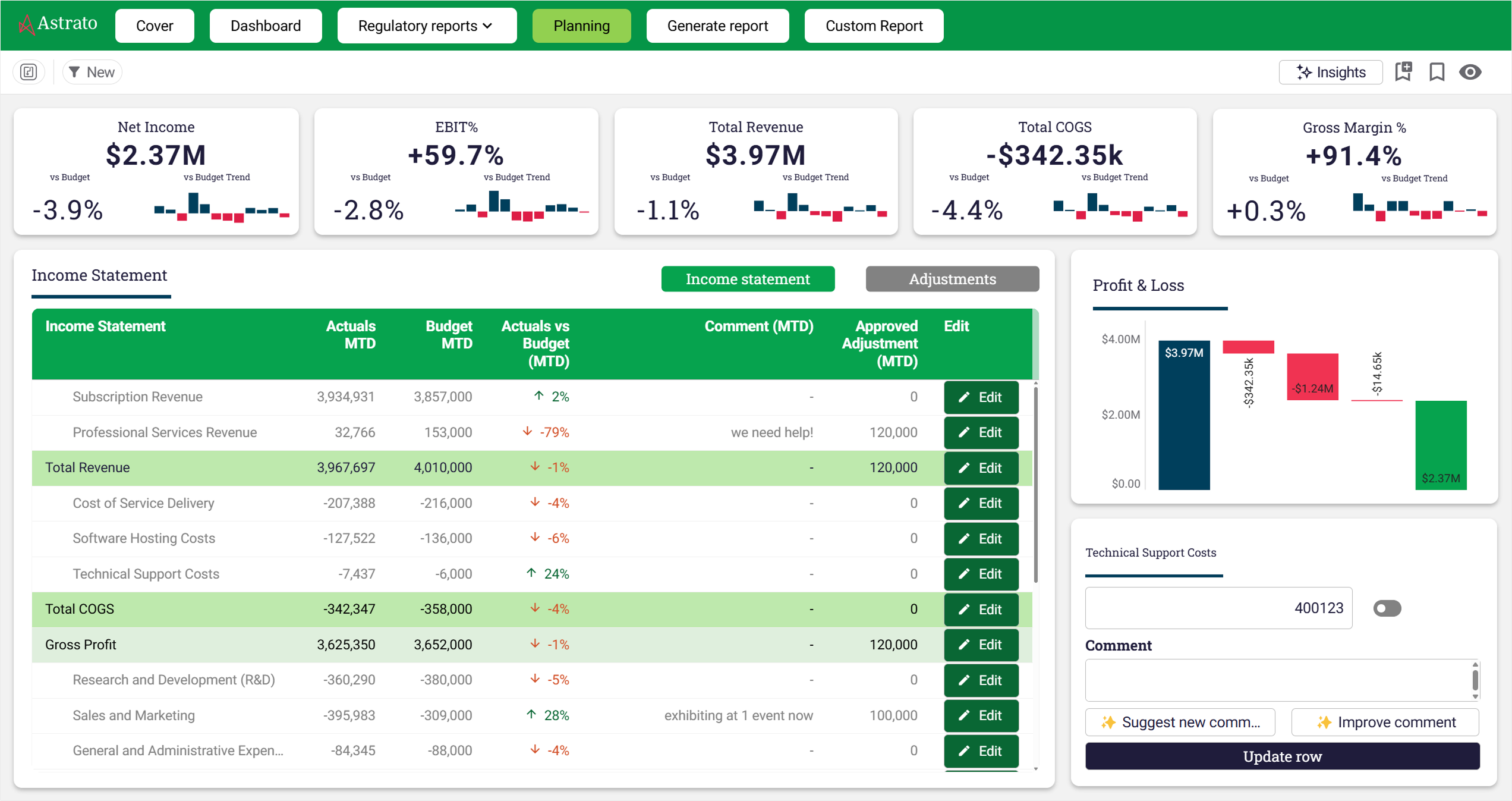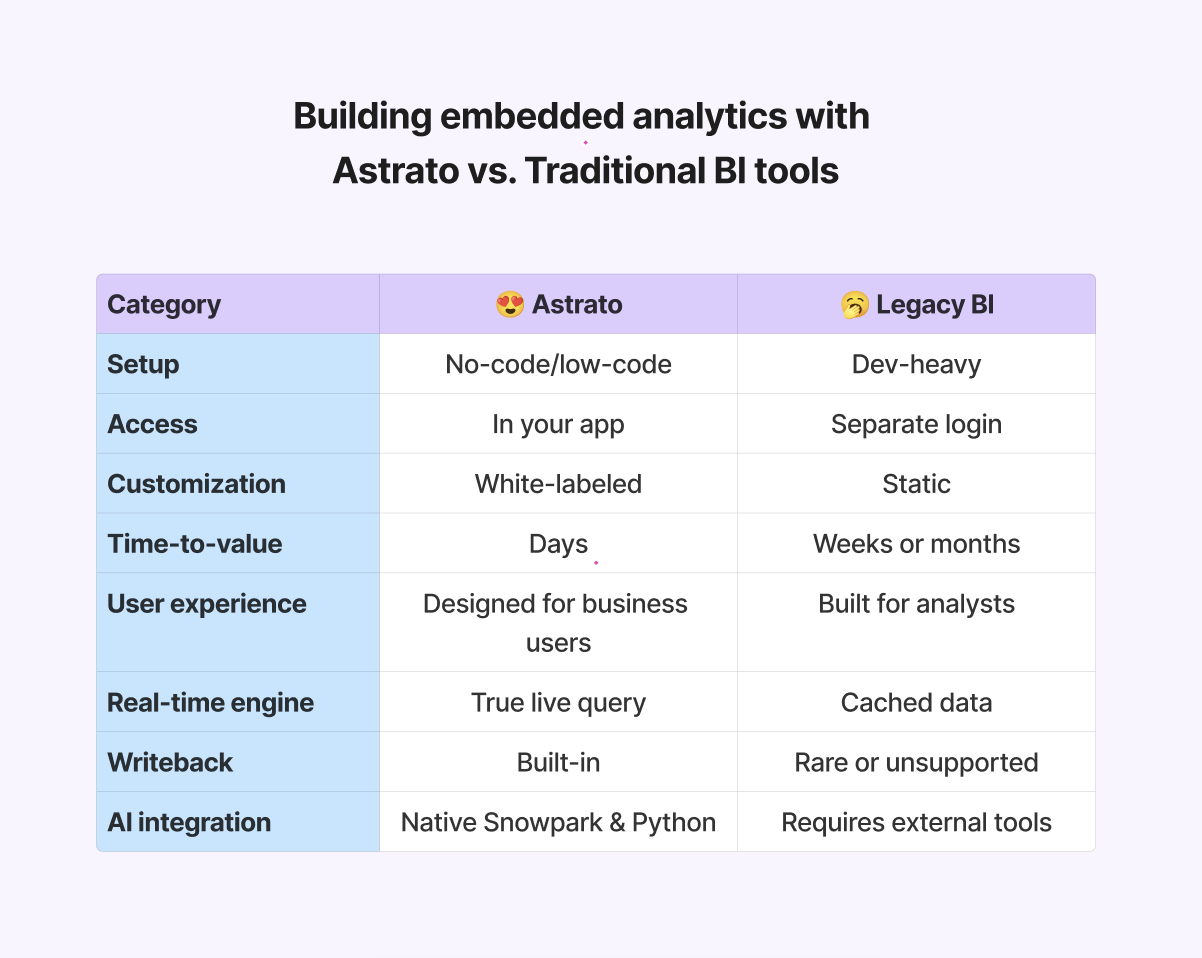You shouldn’t have to switch tools to understand what’s going on.
That’s the core principle behind embedded analytics: bringing real-time insights into the exact interface where work happens. Not in a separate tab or two clicks away, but embedded directly into your product, portal, or internal tool.
For fast-moving teams – especially startups and SMBs – this shift changes everything. You don’t just see what happened but are now able to act while it’s happening. And the result is massive: faster cycles, smarter decisions, and less friction between insight and action.
So: should you build this yourself? Or plug in a modern platform?
This guide will help you unpack the landscape, understand the trade-offs, and decide what embedded analytics should look like for your team.
Why embedded analytics matters now
Legacy BI tools were designed around analysts. Separate dashboards, delayed reporting, and slow refresh cycles made sense when data lived in silos and was consumed by a small group.
But today, the people who need insight are the ones closest to the problem: support reps, operations leads, product managers. They don’t have time to bounce between tabs or interpret stale charts. They need context – fast, relevant, and in the flow of work.
That’s what embedded analytics delivers. Instead of treating data as something you consult after the fact, it becomes part of the process.
Imagine:
- A CS rep sees a live churn risk score while handling a support ticket.
- A sales lead adjusts their forecast directly in the CRM.
- An ops manager updates inventory projections inside the same dashboard that flagged the issue.
Making decisions right there, in the moment – without switching tools or reloading data.

What embedded really means (and why it’s more than a chart)
At its simplest, embedded analytics means integrating analytical capabilities – dashboards, reports, KPIs – directly into the applications people use every day. Think customer service teams seeing NPS trends inside their ticketing system. Or sales reps adjusting forecasts right from the CRM.
It might look like a small UI tweak. In reality, it’s a fundamental shift in how teams use data. Embedded analytics moves insight from the edge of the workflow to the center.
True embedded analytics delivers a complete analytical experience inside another system. It goes beyond static visuals to include:
- Live queries, not cached snapshots
- Full interaction and filtering
- Real-time writeback into the source system
- Role-based security embedded by design
The best implementations feel invisible – users stay in one interface, fully equipped to explore, decide, and act. Astrato enables this simply by using embed links, embedding rich, real-time dashboards that blend seamlessly into your app or portal.
Embedding analytics where work happens
Legacy BI tools made one crucial mistake: they treated analysis as something separate. You had to pause your work, open another tab, and hope the report was recent. Embedded analytics cuts that loop short.
The methods vary, each with its own trade-offs:
- iframes for speed: Easiest to implement. Ideal for fast MVPs or early-stage rollouts, but limited in interactivity and styling control.
- React SDKs for customization: Offers the most flexibility and seamless integration into complex apps. Requires developer resources and React experience.
- Web Components for balance: A middle ground that enables richer UX and customization without needing a full React setup.
But the goal remains the same: frictionless access to live data, right where users already work.
And when the platform includes writeback features, users can take the next step – editing, annotating, or updating data from the same screen. No more Excel exports. No more versioning chaos. Astrato is one of the few BI platforms that enables real-time updates directly within embedded views, turning static dashboards into living workflows.
The most popular use cases for embedded analytics
Embedded analytics typically falls into two categories, each with different goals and technical requirements.
✨ Customer-facing analytics (external data products)
Startups often build analytics into their products as a premium feature. This helps create stickier user experiences and unlocks new revenue streams. Examples include:
- Offering premium dashboards to enterprise customers
- Charging usage-based fees for access to insights
- Tiered access to analytics by user role or subscription level
These use cases demand strong design flexibility, scalability, and white-labeling so analytics feel native to the product experience.
Check out the stories from our customers SwitchRCM, Impensa, GrayDI or PetScreening to see how they've used Astrato to monetize data.
💻 Internal operational analytics
Embedded dashboards also help internal teams operate more efficiently. Whether it's tracking KPIs, validating transactions, or triggering alerts, internal embedded analytics supports daily decision-making in context.
- Finance teams monitoring spend thresholds in real time
- Customer success teams tracking churn signals during support workflows
- Product teams analyzing feature usage directly in planning tools
In both scenarios, embedded analytics reduces tool-switching, accelerates response times, and improves alignment across teams and stakeholders.
The build vs. buy decision: what’s really at stake?
On paper, building your own embedded analytics might look like a cost-saving win – or a chance to fully tailor the experience. But that initial flexibility often hides long-term complexity.
You’re not just designing a dashboard. You’re building a full data product. That means:
- Query optimization for performance at scale
- Role-based security and authentication layers
- Consistent UX across all embed locations
- Data integrity and writeback infrastructure
- Long-term support, upgrades, and maintenance
Each of these areas comes with deep technical overhead. Even well-staffed teams underestimate the hidden costs. A typical pattern:
- Timelines stretch far beyond estimates
- Core engineering focus shifts away from product innovation
- Performance bottlenecks surface under real-world user loads
- Internal teams turn into part-time BI support
And in the end? What you’ve built often lacks the polish, interactivity, and self-service flexibility that users expect.
Buying a platform doesn’t mean giving up control. A modern solution like Astrato provides fully customizable, embeddable dashboards with live data and writeback, while abstracting away the infrastructure burden.
You get:
- Seamless cloud data warehouse integration (Snowflake, BigQuery, and more)
- Real-time analytics with no data lag
- Intuitive design tools for technical and non-technical users
- Built-in writeback and trigger automation
In short: you launch faster, iterate more freely, and stay focused on building your core product.

If you want a scalable solution for your embedded analytics product, read the GoBubble story.
How embedded analytics goes beyond reporting to drive real-time action
Modern teams need more than visibility and they need agency. And that means analytics platforms must evolve from static dashboards to dynamic workspaces.
Writeback: let users take immediate action from within dashboards
Traditional BI tools were read-only. You saw what happened, but couldn’t act on it.
Writeback flips that model. Now, users can update forecasts, log notes, tag teammates, or trigger workflows without switching tools. It’s a direct feedback loop between action and data.
For example, imagine a finance manager reviewing a dashboard that flags overspending in a specific department. Instead of exporting data or starting an email chain, they adjust the budget allocation directly in the dashboard, adding notes and tagging department heads for review. The update is written back to the central warehouse in real time, keeping reporting and governance in sync.

Or take a marketing lead tracking campaign performance. If engagement dips below target, they can log an adjustment to the strategy, assign follow-up actions, and trigger alerts – all from the same interface.
Astrato makes this seamless. Users write directly to cloud warehouses like Snowflake or BigQuery – no middleware, no data exports, no lag.
Empowering teams with self-service tools and autonomy
Empowering business users matters. With self-service capabilities, teams can explore data, build reports, and customize views without waiting in an IT queue.
Astrato’s drag-and-drop UI supports this autonomy. Whether it’s an ops lead tweaking staffing assumptions or a CS manager creating custom churn views, the platform gives non-technical users real control.
Use triggers to make dashboards operational
Embedded analytics isn’t just about what you see – it’s about what happens next.
Modern platforms now integrate action triggers. When thresholds are crossed or metrics change, the system can alert the right users or launch downstream workflows.

For instance, if a pipeline conversion rate falls below a set threshold, sales managers can be automatically notified via Slack to review recent lead activity. Or if marketing spend surges past the monthly cap, a finance lead can receive a dashboard alert and initiate a reallocation workflow – all within the same environment.
Astrato powers this shift from passive reporting to operational response – so dashboards don’t just report change, they help drive it.
How a semantic layer enables trustworthy, accessible metrics
Defining performance metrics shouldn’t require a data scientist.
This is where a semantic layer makes a meaningful difference. By abstracting raw SQL and data logic into consistent business terms, a semantic layer lets teams define and reuse key metrics – like churn rate, LTV, or NPS – without technical complexity.
.png)
With Astrato, users work with a visual layer that maps directly to source data but speaks the language of the business. They can adjust formulas, apply filters, or test assumptions – all within a no-code interface that ensures consistency across teams.
This eliminates metric drift, reduces dependency on analysts, and empowers teams to take ownership of the numbers they rely on.
Whether your CS team is adjusting how "at-risk" is defined, or your product team is building a custom engagement funnel, the logic lives in one place – reusable, understandable, and always aligned.
Schedule data delivery to match decision-making cadence
Great insights don’t wait to be opened. In fast-paced environments, timely access to data can mean the difference between a proactive adjustment and a missed opportunity.
Automated, scheduled reporting ensures that critical metrics reach decision-makers at the right moment – whether during daily standups, weekly sales reviews, or quarterly planning sessions. It shifts the workflow from reactive to informed, reducing time spent chasing updates and increasing confidence in every decision.
The result: better coordination, more consistent execution, and a culture where insight becomes habit, not a hunt.
Make embedded dashboards feel native to your product
Embedding analytics isn’t just a technical choice – it’s a design decision.
Astrato supports full white-labeling, clean UI defaults, and responsive performance. Your dashboards feel native to your product and mirror your brand – not ours. And going from concept to embed takes minutes, not sprints.
Bring contextual AI into analytics with native LLMs and semantic logic
The rise of large language models (LLMs) has opened the door to more natural, intuitive ways of interacting with data. But simply adding a chatbot to your BI tool isn’t enough.
To work reliably, AI needs context. Business context. That’s why embedding AI directly into the data warehouse matters.
Snowflake Cortex is designed to keep AI close to the data – with no movement, no pipelines, and no external syncs. For embedded analytics, that means you can query, classify, or enrich data using LLMs in real time, without compromising performance or security.
What makes this powerful is the addition of a semantic layer. Instead of relying on vague column names or brittle query patterns, the AI understands your business logic – so "sales of Apple" won’t confuse fruit with iPhones.
Use cases include:
- Validating form inputs or tagging anomalies as data is entered
- Powering natural language search over structured dashboards
- Automating content classification or enrichment at the point of decision
The result: AI-enhanced analytics that supports actual work – not just novelty. Done right, this approach brings speed and scale to everyday decisions, while preserving trust in the data. Astrato integrates natively with Snowflake Cortex, ensuring that large language models operate securely and contextually within your existing data environment.
The difference between live queries and cached data – and why it matters
Live queries connect straight to your cloud data – executing SQL directly against the source every time a dashboard loads or a filter changes. This ensures that what you see reflects the most current state of your business.
By contrast, many traditional BI tools rely on cached data, which is extracted and stored on a schedule. That might mean seeing data from last night’s batch job – or worse, a snapshot that’s days old.
For teams making decisions in the moment, that delay can lead to missed opportunities or outdated conclusions. Real-time queries keep dashboards aligned with reality, so action is always grounded in what’s actually happening.
Together, these features define what it means to be action-ready – and why modern embedded analytics isn’t just a reporting tool, but a foundation for smarter, faster work.
Astrato vs. traditional tools
Traditional BI platforms were built for centralized teams and periodic reporting. Embedding them in a product or workflow often requires complex workarounds – managing data extracts, dealing with rigid interfaces, or customizing at great cost.
By contrast, Astrato was designed for embedded use cases from day one.

Key questions to evaluate any embedded analytics platform
Choosing an embedded analytics platform isn’t just about checking boxes – it’s about aligning the tool to your team's workflows, technical capabilities, and business goals.
Here are five questions to guide your decision:
- Can we go live in under a week?
Time-to-value matters. Fast implementation means you start learning and iterating sooner. - Will non-technical users be able to build and explore?
Self-service empowers more people to engage with data and reduces dependency on engineering teams. - Does this connect to our existing data stack?
Seamless integration with your cloud data warehouse (like Snowflake or BigQuery) avoids data duplication and sync issues. - Can we monetize the analytics experience?
If you're building a customer-facing product, the ability to tier access, white-label, or add premium dashboards can open new revenue streams. - Is there support for writeback, automation, and live queries?
These are the features that turn passive dashboards into active decision-making tools.
The right answers depend on your team, your product, and your pace. But clarity on these points can save months of trial and error.
This is the next phase of BI
Embedded analytics isn’t just a feature upgrade – it’s a rethinking of how data fits into decision-making.
Instead of toggling between dashboards and action, teams operate from a single interface where insights and execution converge. When writeback, real-time data, and contextual automation are built in, analytics becomes a true operational layer – not just a reporting tool.
The takeaway: modern teams don’t want more tools. They want smarter workflows. Embedded analytics powers that shift – making data-driven decisions faster, more intuitive, and closer to the moment they matter most.






.avif)








